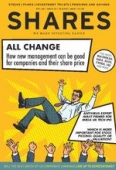Archived article
Please note that tax, investment, pension and ISA rules can change and the information and any views contained in this article may now be inaccurate.
How much investment risk do I need in retirement?

Getting the right balance between investment growth and risk is important for every investor, but for retirees it is even more crucial.
You need to ensure your money keeps growing so that it lasts throughout your retirement, and protect yourself from a market crash that could wipe out your savings.
WHY DO I NEED INVESTMENT GROWTH IN RETIREMENT?
The retirement landscape is vastly different than it was when your parents retired.
Most people used to work towards a retirement date when they would buy an annuity – a policy that provides a guaranteed income for life. It made sense to gradually reduce investment risk in the lead up to that date.
Nowadays many people opt for income drawdown, where there isn’t a clean cut-off date.
Drawdown offers investors flexibility and control, but the lack of a guarantee means investments have to carry on working for the rest of your life.
These challenges are compounded by the fact that retirees today have much longer life expectancies than their parents and grandparents did. A man aged 65 can now expect to live to 85.6 years and a woman to 87.8 years, according to the Office for National Statistics.
That means you might need your pension to last for more than 20 years.
‘In simple terms, if you have a drawdown pension that you depend upon which suffers continuous poor growth after charges and inflation, you are unlikely to have a sustainable retirement, and your standard of living will eventually reduce,’ says Oliver Smyth, financial adviser at Walker Crips Wealth Management.
‘It is crucial to match your attitude to investment risk with realistic income objectives to ensure you have a coherent strategy for a sustainable retirement.’
HOW MUCH RISK IS TOO MUCH?
If you want to grow your investments, you need to take on risk. That means investing in the stock market.
But if you take on too much risk it could have a devastating impact on the value of your pension.
Once you start withdrawing money from your pension, the impact of a stock market downturn becomes far greater. As fund values drop, you need to sell down a higher proportion of your fund to generate the same income. This means you’ll deplete your pension pot far more quickly.
‘High levels of income withdrawal when capital values are suppressed can be particularly destructive,’ says Charles Calkin, financial planner at James Hambro & Co.
‘The right level of risk is a sensible balance between giving you income and potential for capital growth to protect against inflation and not putting your security in jeopardy.’
HOW DO I MEASURE RISK?
What constitutes too much risk is personal to each retiree.
This is because you need to assess your capacity for loss – i.e. how much your lifestyle would be affected if you were to suffer a significant loss from your pension.
Smyth says if a retiree requires 10% of their fund as an income each year, this is unlikely to be achieved via a cautious or medium risk portfolio.
However, if the retiree doesn’t have a great deal of capacity for loss, then pursuing a higher risk strategy could be harmful in more negative market conditions.
‘In this instance, it may be more beneficial to revise your lifestyle and spending to see if there is any way to decrease the burden on your drawdown income and create a more sustainable retirement plan,’ Smyth adds.
Simon Molica, fund manager at AJ Bell, says many retirees are probably not taking on enough risk within their overall pot of wealth.
‘The last decade has demonstrated the danger of having too much wealth tied up in bank saving accounts, which potentially can erode purchasing power, especially given today’s low interest rate environment,’ he says.
‘It is important to ensure that the income generated from your investments is not slowly eroding the capital of your wealth in an unexpected manner.’
WHAT SHOULD I INVEST IN?
Matt Swatton, private client partner at Thomas Miller Investment, suggests that a typical 65 year-old seeking investment growth that isn’t overly risky should aim for a 30% to 50% allocation to equities. The remainder would be split between bonds, gilts, property, alternatives and cash.
Swatton reckons Standard Life Investments MyFolio Market III (GB00B758J660) is worth looking at. The fund aims to generate a total return from a combination of income and capital growth by solely investing in passive funds.
‘The passive portfolio construction of the fund means that the overall cost of the underlying holdings are cheaper, which would suit a client with a smaller retirement pot,’ says Swatton.
‘As it’s designed for a client with a balanced attitude to risk – who isn’t necessarily seeking risky investments but isn’t avoiding them either – it would seem to suit a retired investor with a longer-term time horizon.’
AJ Bell’s Simon Molica favours Fidelity MoneyBuilder Income (GB00B3Z9PT62) and TB Evenlode Income (GB00BD0B7D55), both of which focus on generating income.
Fidelity MoneyBuilder Income is a UK corporate bond fund which aims to produce a strong level of income, low volatility and equity diversification.
Evenlode Income is a UK equity fund which seeks to invest in quality companies with resilient profit streams, sustainable growth profiles and limited capital reinvestment needs or reliance upon leverage.
If you’re not comfortable picking individual funds, a multi-asset fund is a simpler option. These ‘one-stop-shop’ funds spread your money across lots of different assets according to a specified risk profile.
Important information:
These articles are provided by Shares magazine which is published by AJ Bell Media, a part of AJ Bell. Shares is not written by AJ Bell.
Shares is provided for your general information and use and is not a personal recommendation to invest. It is not intended to be relied upon by you in making or not making any investment decisions. The investments referred to in these articles will not be suitable for all investors. If in doubt please seek appropriate independent financial advice.
Investors acting on the information in these articles do so at their own risk and AJ Bell Media and its staff do not accept liability for losses suffered by investors as a result of their investment decisions.
Issue contents
Big News
- JD Sports is still fighting fit
- ImmuPharma collapses on trial failure
- British Airways owner eyes takeover of Norwegian Air
- Apollo stalks FirstGroup with takeover interest
- Pound pushes to highest level since Brexit vote
- Cyber security firm Avast set for £2.8bn IPO
- Activist investor Elliott rumoured to have Micro Focus in its sights
- Costa spin-off calls at Whitbread gain momentum

 magazine
magazine








